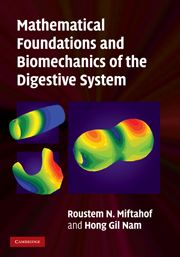Book contents
- Frontmatter
- Contents
- Preface
- Notation
- Introduction
- 1 The geometry of the surface
- 2 Parameterization of shells of complex geometry
- 3 Nonlinear theory of thin shells
- 4 The continuum model of the biological tissue
- 5 Boundary conditions
- 6 Soft shells
- 7 Biomechanics of the stomach
- 8 Biomechanics of the small intestine
- 9 Biomechanics of the large intestine
- 10 Biological applications of mathematical modelling
- References
- Index
10 - Biological applications of mathematical modelling
Published online by Cambridge University Press: 06 July 2010
- Frontmatter
- Contents
- Preface
- Notation
- Introduction
- 1 The geometry of the surface
- 2 Parameterization of shells of complex geometry
- 3 Nonlinear theory of thin shells
- 4 The continuum model of the biological tissue
- 5 Boundary conditions
- 6 Soft shells
- 7 Biomechanics of the stomach
- 8 Biomechanics of the small intestine
- 9 Biomechanics of the large intestine
- 10 Biological applications of mathematical modelling
- References
- Index
Summary
Biomechanics of hollow abdominal viscera
Mathematical modelling has greatly increased our ability to gain an understanding of many complex biological phenomena. A model can be treated as a hypothesis that can be accepted or rejected on the basis of its ability to predict the experimentally observed results. Numerical simulation techniques are most powerful when a mathematical model is based on understood individual elements of the biological systems, but where their aggregate behaviour cannot be depicted by current theory. In the absence of unexpected interactions, the input–output relationship can be quite accurately calculated. Experimentally inaccessible and sometimes unexpected interactions can be recovered and evaluated by simple comparison of computed versus experimental results. Such use has made mathematical simulation an indispensable tool in the biosciences.
After decades of experimental optimism, there is increasing recognition of the limitations of the in vivo and in vitro approaches to the study of gastrointestinal function. Possible explanations of these limitations are the size, variable contour and inaccessibility of abdominal viscera and most importantly the fact that existing techniques do not allow us to unravel the multilevel, nonlinear interactions that occur in complex physiological reactions. Today, without employment of the methods of mathematical modelling based on the general principles of computational biology our potential to learn about the complex relationships within the gastrointestinal tract would be totally thwarted.
Information
- Type
- Chapter
- Information
- Publisher: Cambridge University PressPrint publication year: 2010
